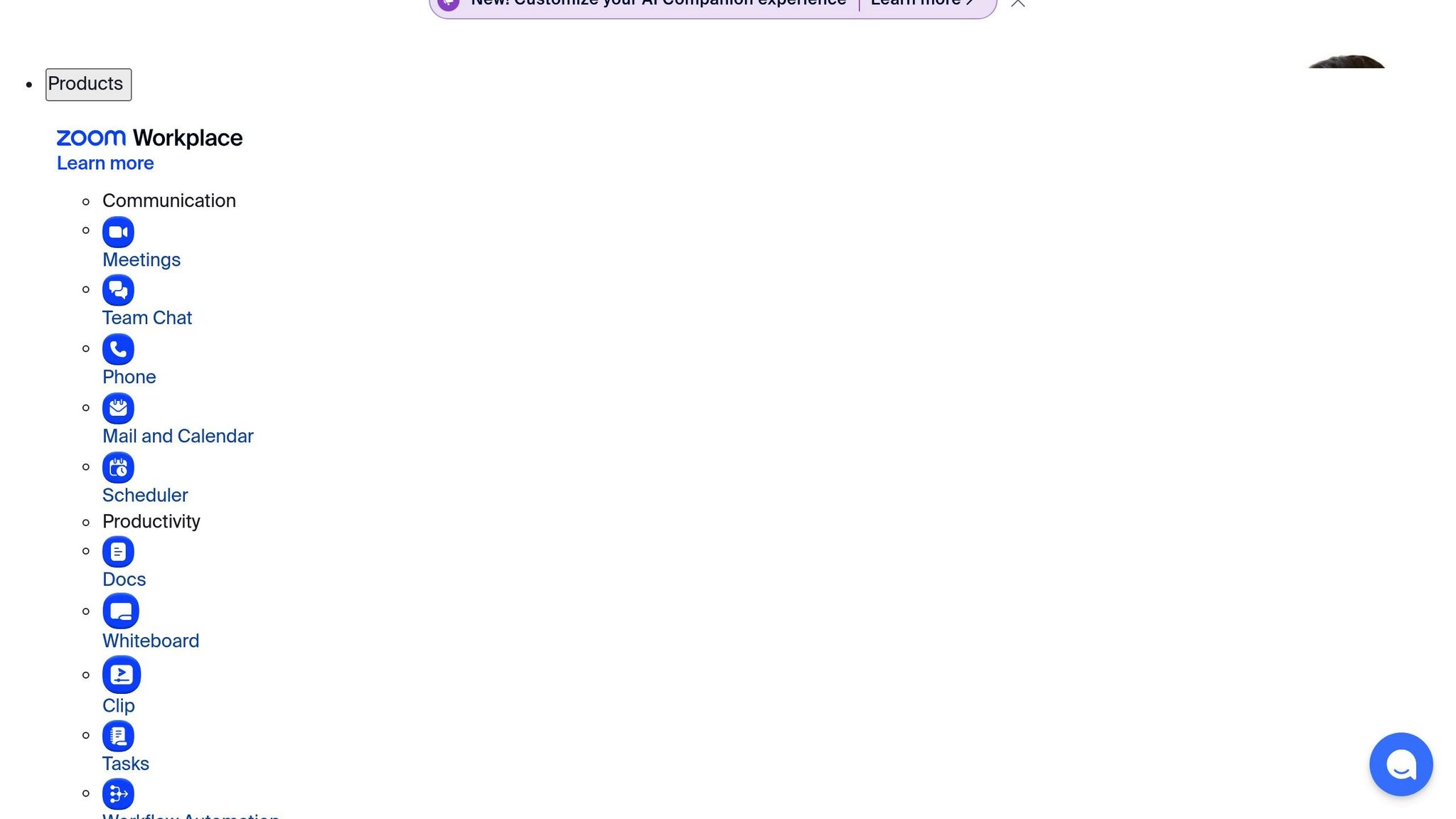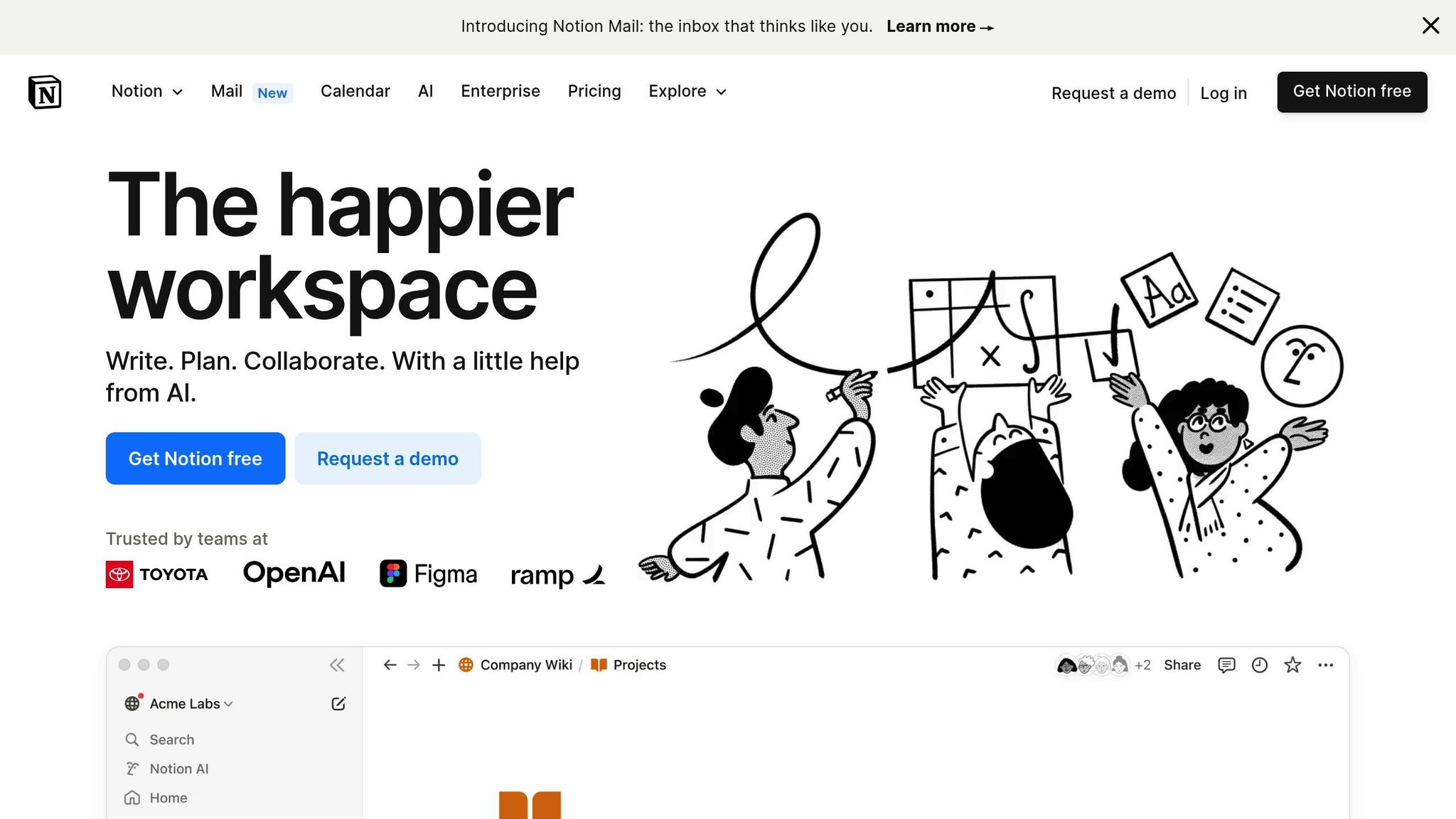
Remote Team Productivity: 8 Essential Tools
Tanvi Mehta
Apr 19, 2025
Working remotely? Struggling with productivity and team collaboration? Here’s a quick guide to the 8 must-have tools that can help your team stay connected, organized, and efficient:
Stacks: AI-powered content management to organize tasks, documents, and workflows.
Slack: Real-time team chat with app integrations and automation.
Asana: Project tracking with multiple views like Kanban, Gantt charts, and calendars.
Trello: Visual board-based task management for simple, drag-and-drop planning.
Microsoft Teams: All-in-one workspace for chat, meetings, and file sharing.
Zoom: Video conferencing with AI features like meeting summaries and translations.
Notion: Centralized knowledge hub for team documentation and collaboration.
Clockwise: AI calendar tool to optimize schedules and create focus time.
Quick Comparison:
| Tool | Starting Price | Free Plan Features |
|---|---|---|
| Stacks | $9/month | Unlimited resources, 1 personal workspace |
| Slack | $8/month | 90-day message history, 10 app integrations |
| Asana | $10.99/month | Free for up to 10 users |
| Trello | $5/month | Unlimited boards, 10 card automations |
| Microsoft Teams | $4/month | Up to 300 participants, 2 GB/user storage |
| Zoom | $14.99/month | 40-minute meetings, 100 participants |
| Notion | $8/month | Unlimited pages, blocks; 5 guests |
| Clockwise | $6.75/month | Basic scheduling features |
These tools simplify communication, project management, collaboration, and scheduling - key challenges in remote work. Dive in to find the right fit for your team.
1. Stacks: Content Management with AI

Stacks tackles the challenge faced by 53% of remote workers who find it hard to stay connected [1]. It’s an all-in-one content management platform powered by AI, designed to streamline organization and boost collaboration.
With its user-friendly interface, Stacks simplifies managing projects, tasks, and documents. AI-driven categorization ensures everything is neatly organized, while the Super Search feature helps you find information across your workspace in seconds, saving valuable time.
"Before Stacks, everything I did was through the browser, but I craved an offline app that would work as well as Trello or Basecamp. Now I have it! I can go off grid with Stacks and still keep track of my workload easily." - Rory O., Developer [2]
Stacks also automates repetitive tasks, letting teams focus on what matters most. It supports customizable workflows with multiple views to suit different needs:
| View Type | Ideal For |
|---|---|
| Kanban Boards | Tracking projects visually |
| Tables | Managing data-heavy tasks |
| Lists | Organizing sequential workflows |
| Calendars | Planning based on timelines |
For those concerned about data security, Stacks allows you to store data locally or on a self-hosted server, ensuring complete control over sensitive information.
"The UI and features of Stacks are superior to other task boards. AND the data is local – so no privacy concerns." - Erik L., PM [2]
Pricing is straightforward, catering to teams of all sizes:
Basic: Free plan
Stacks Pro: $49 one-time payment
Stacks Enterprise: $5 per seat, per month (includes advanced privacy features) [2]
Stacks also features a robust note-taking system that integrates seamlessly with project management, keeping tasks and documentation in one place.
Up next, we’ll dive into Slack and how it powers real-time communication for distributed teams.
2. Slack: Team Chat Platform

Slack serves as the hub for real-time team communication, helping teams stay connected and organized. By structuring conversations, files, and apps into channels, Slack users have reported impressive results: 87% say collaboration is more efficient, and productivity increases by 47% [4].
"Channel organization transformed our team's response time. We cut email back-and-forth by 60%."
- Alex M., Remote Operations Lead
With integrations for over 2,600 apps and built-in automation, Slack simplifies workflows, saving teams 35% of work time and consolidating an average of 43 apps per workspace [4].
Slack Plans
Slack offers three plans tailored to different needs [4]:
Free: Access to 90-day message history and 10 app integrations - perfect for small teams.
Pro: Includes unlimited message history, app integrations, group meetings, and external collaboration tools.
Enterprise Grid: Designed for large organizations with unlimited workspaces, employee directories, and advanced management features.
When Unity, with 3,400 employees, transitioned to fully remote work, engagement in their #unity-all channel increased by 120% in just a few days [3].
External Collaboration and Compliance
Slack Connect is a favorite among large enterprises, with 80% of Fortune 100 companies using it to collaborate with external partners and customers. Each week, 4 million people use Slack Connect for external teamwork [4].
On the compliance front, Slack meets industry standards like SOC 2/3, ISO 27001, GDPR, HIPAA, and FINRA, ensuring data security. Meanwhile, Slack AI enhances productivity by offering smart search and automatic recaps, saving teams an average of 97 minutes per week [4].
Next: Asana streamlines project tracking for remote teams.
3. Asana: Project Tracking

Asana simplifies task management and improves visibility for remote teams, helping them stay organized and productive [6]. Following Slack's real-time communication, Asana serves as a central hub for tracking projects across teams.
Project Organization Features
Asana provides multiple ways to organize and view projects, catering to different team needs:
List view: Ideal for managing tasks in order.
Calendar view: Helps keep track of deadlines.
Timeline/Gantt chart: Useful for mapping out project roadmaps.
Kanban boards: Perfect for agile workflows [6].
"Asana lets us bring project management to the entire organization without the need for much education, because the platform is so easy to use. Junior specialists work perfectly in Asana, and executives do the same."
- Aleksandra Sulimko, Chief Human Resources Officer, TheSoul Publishing [6]
Integration Capabilities
Asana connects seamlessly with over 270 apps, including Slack, Google Drive, Outlook, Gmail, and Zoom [7].
"When you're moving this fast as an organization, it's important to be on the same page and have a centralized tool to hold people accountable."
- Marc Seitz, Senior Security Program Manager, Threat and Vulnerability Management at Zoom [6]
Benefits for Remote Teams
Remote teams gain a lot from Asana's features, making collaboration and project management easier:
| Feature | Purpose |
|---|---|
| Custom Fields | Track data specific to your project. |
| Status Updates | Get real-time progress insights. |
| Task Dependencies | Visualize workflows clearly. |
| Time Tracking | Manage resources more effectively. |
"Asana has been extra helpful as we've all gone remote and quickly pivoted focus. Everyone can stay up to date on contributions, stakeholder approvals, and timelines which has transformed how we work. We're now more collaborative, accountable, and efficient in hitting our deadlines."
- Joe LaGrutta, Manager, Senior Strategy & Operations at 15Five [7]
Asana is free for up to 10 users [5], with paid plans available for larger teams.
Next: Learn how Trello’s board-based system simplifies visual project management.
4. Trello: Board-Based Planning
Trello's visual boards provide an easy-to-use, drag-and-drop system for project management, making it a great complement to Asana's structured approach. A recent survey showed that 74% of users experienced better team communication after adopting Trello [9].
Trello organizes projects using three main elements: boards (workspaces), lists (workflow stages), and cards (tasks). This setup allows teams to visually track progress and stay aligned.
"Whether someone is in the office, working from home, or working on-site with a client, everyone can share context and information through Trello." - Sumeet Moghe, Product Manager at ThoughtWorks [9]
The platform's transparency helps teams make decisions faster and ensures accountability, even when working remotely. In fact, 75% of organizations see measurable improvements within just 30 days, thanks to features like real-time collaboration on cards, simplified workflows, and instant visual updates [9].
"[Trello is] great for simplifying complex processes. As a manager, I can chunk [processes] down into bite-sized pieces for my team and then delegate that out, but still keep a bird's-eye view." - Joey Rosenberg, Global Leadership Director at Women Who Code [9]
Business Impact
Trello's popularity among businesses speaks for itself - 80% of Fortune 500 companies use it to manage their projects [10]. A standout example is SwagUp, which leveraged Trello to achieve rapid growth:
"Not only did [Trello] unify our process and help everyone understand their role, but we were able to automate essential steps of the process so we could move a lot faster and grow to a multi-million dollar company with a team of ten." - Founder, SwagUp [8]
Pricing Structure
Trello provides several pricing tiers to fit different team sizes and needs:
Free: Up to 10 collaborators per workspace
Standard: $5/user/month (billed annually)
Premium: $10/user/month (billed annually)
Enterprise: $17.50/user/month (billed annually) [8]
Next: Discover how Microsoft Teams creates an all-in-one workspace for remote collaboration.
5. Microsoft Teams: All-in-One Workspace

Microsoft Teams combines chat, meetings, file sharing, tasks, and apps into a single platform, offering a streamlined workspace for remote teams. Inspired by Trello's visual boards, Teams integrates tools essential for collaboration and productivity [11].
Key Features
Video conferencing with PowerPoint Live and Microsoft Whiteboard integration
Channel-based communication for chat and file sharing
Task management with collaborative tools and shared workspaces
Microsoft Loop components for real-time document editing
AI meeting tools, including automated transcription and notes
"Teams provided the capacity we needed to ramp up our conferencing capabilities during a critical time." - Ryan Wright, Lead Engineer of Unified Communications, REI [11]
Business Impact
Major companies like L'Oréal rely on Teams to enhance collaboration within their organizations:
"We use Teams to create the sense of belonging that empowers beauty advisors to be the best ambassadors for their individual brands." - Nicolas Koller, Head of IT Retail, L'Oréal [11]
Next: Zoom offers HD video meetings and AI-driven transcriptions for seamless remote teamwork.
6. Zoom: Video Meetings

Zoom continues to be a go-to tool for remote collaboration, offering seamless video conferencing and unified communication. According to Forrester Consulting, Zoom users save an average of 52 minutes of productivity per employee each week [12].
Key Features
AI Companion: Provides transcription, meeting summaries, agenda creation, multi-language captions, integrated chat, file sharing, and cloud recording.
Team Chat: Includes rich-text editing and third-party app integrations for enhanced communication.
Business Benefits
Zoom's AI-powered tools help teams:
Automatically create meeting agendas.
Capture and share action items with ease.
Access real-time summaries of key points and next steps.
Overcome language barriers with instant translations.
Speed up sales cycles, improving time-to-value by up to 70% [12].
"Since we started using Zoom, we communicate better and work more efficiently. We have become much faster. In the way we develop things and how we respond to requests from partners and customers. With Zoom, we're much more agile." - Frank Menne, Managing Director, OctoGate IT Security Systems GmbH [13]
Pricing Options [26]
| Plan | Cost | Key Features |
|---|---|---|
| Free | $0 | 40-minute limit on group meetings |
| Pro | $14.99/month/host | Extended meetings, cloud recording |
| Business | $19.99/month/host | Company branding, meeting transcripts |
| Enterprise | $19.99/month/host | Unlimited cloud storage, dedicated support |
Collaboration in Action
"When I'm working with our leadership team, we use Zoom Whiteboard so that we can pop it up in the room during a meeting, or on our screens at home when one of us is remote. We can still be looking at the same thing, collaborating, and keeping that work going, which has been huge." - Jeremy Raleigh, Software Project Manager, TechSmith [13]
Next: Discover how Notion centralizes team knowledge for streamlined collaboration.
7. Notion: Team Wiki Platform

After productive Zoom meetings, teams often need a centralized space to share and organize knowledge. That's where Notion comes in. It serves as a hub for team documentation, making it easier for remote teams to collaborate and keep everything in one place [14].
Notion’s block-based editor allows users to create custom wikis, document libraries, task databases, and project boards with over 100 content types [14].
Key Features
| Feature | What It Does | Why It Matters |
|---|---|---|
| Building Blocks | Customizable content structure | Makes organizing information easier |
| Collaborative Tools | Real-time editing and commenting | Encourages better team communication |
| AI Integration | Answers document queries instantly | Speeds up decision-making |
| Connected Workspace | Integrates with essential tools | Simplifies workflows |
Notion’s real-time collaboration features let teams edit, comment, and share content seamlessly. This creates a more interactive and efficient work environment [14][15].
Integration Capabilities
Notion's AI Connectors beta feature makes it easy to integrate with tools like Slack and Google Drive. This allows teams to:
Pull Slack conversations directly into Notion pages
Import and edit Google Drive documents
Create a unified knowledge base across platforms
These integrations ensure your team’s knowledge stays organized and accessible, no matter where it originates [15].
Next: Learn how Clockwise helps remote teams manage their schedules more effectively.
8. Clockwise: Smart Calendar Tool

Once teams centralize their knowledge in Notion, the next step is streamlining schedules. Clockwise uses AI to organize calendars, creating more uninterrupted focus time and aligning meetings with individual preferences by analyzing 160 million daily meetings [16].
"We're using a number of AI tools to help us drive efficiencies internally at Instacart, and Clockwise is one of our most adopted AI products. It's the tool our team loves the most to keep their days running smoothly." [16]
"Engineers have seen an improvement in heads-down time and ability to get work done, which of course is productivity and ultimately business impact. That's been a huge help." [16]
Clockwise helps teams focus by freeing up time for deep work. It works seamlessly with platforms like Notion and Slack, reducing time spent on coordination so teams can focus on creating.
| Feature | What It Does | Why It Matters |
|---|---|---|
| Focus Time Blocks | Creates 2+ hour work periods | Supports deep concentration |
| Smart Meeting Breaks | Adds gaps between meetings | Prevents meeting burnout |
| Lunch Breaks | Blocks time for lunch | Encourages work-life balance |
| Flexible Meeting Detection | Spots reschedulable meetings | Boosts scheduling flexibility |
| One‑Click Actions | Simplifies RSVP and rescheduling | Speeds up calendar tasks |
| Group Scheduling | Combines team availability | Finds the best meeting times |
Clockwise runs millions of scheduling scenarios, sends invites, resolves conflicts, and syncs out-of-office and remote work events with the team calendar - all while respecting working hours and individual preferences [16][17].
Next: Explore our tools' features and pricing.
Tool Features and Pricing
Here’s a quick overview of the free tiers and starting prices for eight popular tools:
| Tool | Starting Price | Free Plan Details |
|---|---|---|
| Stacks | $9/month | Unlimited resources, 1 personal workspace |
| Slack | $8/month | 90-day message history, 10 app integrations |
| Asana | $10.99/month | Free for up to 10 users |
| Trello | $5/month | Unlimited boards, 10 card automations |
| Microsoft Teams | $4/month | Up to 300 participants, 2 GB/user storage |
| Zoom | $14.99/month | 40-minute meetings, 100 participants |
| Notion | $8/month | Unlimited pages, blocks; 5 guests |
| Clockwise | $6.75/month | Basic scheduling features |
All these tools include a free tier, but upgrading to a paid plan provides access to features like extra storage, advanced analytics, and priority support.
Check out the details to decide which tool best fits your team’s needs.
Summary
By 2025, around 32.6 million Americans are expected to work remotely [1]. To tackle the challenges of remote work, here are some AI-powered tools making a difference:
Better Communication: Tools like Slack and Microsoft Teams use AI to prioritize messages, offer real-time translation, and generate meeting summaries, helping teams stay connected across time zones.
Smarter Workflow Management: Platforms such as Trello and Asana automate task tracking, predict potential bottlenecks, and suggest solutions to keep projects on track.
Improved Collaboration: Notion supports document collaboration with smart text suggestions, while Zoom enhances virtual meetings with features like noise suppression and engagement tracking.
Organized Content Management: Stacks leverages AI to categorize documents and provide instant access to information using its Super Search feature.
Efficient Scheduling: Clockwise optimizes calendars by creating focused work blocks and minimizing meeting overload.
These tools address key areas of remote work - communication, project management, collaboration, and scheduling - helping teams stay productive and connected.
AI-powered chatbots, automated scheduling, and streamlined workflows are transforming how virtual teams operate, reducing manual tasks and improving efficiency.